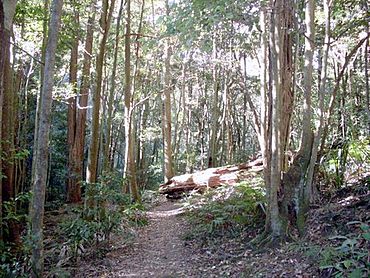Macquarie Pass National Park facts for kids
Quick facts for kids Macquarie Pass National ParkNew South Wales |
|
|---|---|
|
IUCN Category II (National Park)
|
|

Rainforest in the park
|
|
| Established | 3 December 1969 |
| Area | 11 km2 (4.2 sq mi) |
| Managing authorities | National Parks and Wildlife Service (New South Wales) |
| See also | Protected areas of New South Wales |
Macquarie Pass National Park is a special natural area in New South Wales, Australia. It's about 90 kilometers (56 miles) southwest of Sydney. The park is named after Macquarie Pass, a winding road that goes through the beautiful Illawarra escarpment.
This national park was created in 1970. It protects many different kinds of forests. You can find eucalypt forests and even rainforest here. It's home to one of Australia's most southern subtropical rainforests. The Macquarie Pass road itself opened in 1898. It has been an important way to travel to and from the Illawarra coast ever since.
The park is full of amazing wildlife. You might spot many different kinds of birds. There are also swamp wallabies and wombats living here.
Contents
Park History
Long ago, in the early 1800s, the area around Macquarie Pass was used for logging. People cut down many cedar trees from the forests.
Visiting the Park
Macquarie Pass National Park has places for visitors to enjoy. You can find picnic areas at the bottom of Macquarie Pass. Some spots even have barbecues for cooking.
Walking Tracks
The park has several walking tracks. They let you explore the different forests and see the wildlife.
Macquarie Rivulet Track
This track is two kilometers (1.2 miles) long. It's an easy to medium walk. The path follows the Macquarie Rivulet. You might see birds like the dollarbird, azure kingfisher, and golden whistler here.
Cascade Falls Walk
This walk is one kilometer (0.6 miles) long and is an easy path. It goes along Cascade Creek to a small waterfall. Look for birds like the green catbird and rose robin. You might also see interesting fungi growing here.
Clover Hill Road Track
This track is 3.5 kilometers (2.2 miles) long and is an easy walk. It follows a maintenance trail. You'll find several waterfalls and a large balancing rock along the way. The rock is about 50 meters (164 feet) tall! Birds you might spot include the white-throated treecreeper and topknot pigeon. If you visit at night, you might even hear or see a powerful owl or sooty owl.
Glenview Walk
The Glenview walk is two kilometers (1.2 miles) long and is an easy track. It goes through tall forests. Birds like the variegated fairy-wren and crested shrike-tit can be seen here.
Upper Cascade Creek Walk
This track is two kilometers (1.2 miles) long. It's a moderate walk, meaning it's a bit more challenging than the easy tracks.
Brown Barrel Walk
This is a shorter track, only half a kilometer (0.3 miles) long. It's an easy to moderate walk. It goes through rainforest and moist eucalypt forests. The track is named after the Eucalyptus fastigata tree, also known as the brown barrel. Keep an eye out for superb lyrebirds, pilotbirds, and king parrots.
Mount Murray Road Track
This track is 1.5 kilometers (0.9 miles) long and is an easy loop walk. You might see birds like the red-browed treecreeper and satin flycatcher here, especially from late spring to autumn.
Images for kids
See also
 In Spanish: Parque nacional Paso Macquarie para niños
In Spanish: Parque nacional Paso Macquarie para niños



